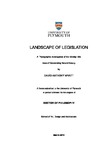Landscape of Legislation: A Photographic Investigation of the Mendip Hills Area of Outstanding Natural Beauty
| dc.contributor.supervisor | Wells, Liz | |
| dc.contributor.author | Wyatt, David Anthony | |
| dc.contributor.other | School of Art, Design and Architecture | en_US |
| dc.date.accessioned | 2019-06-12T12:24:13Z | |
| dc.date.available | 2019-06-12T12:24:13Z | |
| dc.date.issued | 2019 | |
| dc.identifier | 10417139 | en_US |
| dc.identifier.uri | http://hdl.handle.net/10026.1/14307 | |
| dc.description | This thesis comprises five pdf books. The first contains the written contextualisation and analysis, and the remaining four the outcome of the photographic practice. | en_US |
| dc.description.abstract |
This study used the researcher’s own photographic practice to interrogate the judgements of value explicit in the creation and maintenance of the Mendip Hills ‘area of outstanding natural beauty’ (AONB). The objective was to investigate what photography could say about the aesthetic judgements associated with such a designation. This was examined through identifying four case studies, all geographically located within the AONB, in order to explore the potential and limitations of diverse photographic methods. At each site, maps were created as part of the research thereby allowing site-specific conservation information to lead the practice. These locations were then photographed as part of their wider surroundings with a pictorial strategy that was aimed at identifying this as a place associated with an idea of ‘Natural Beauty’. In the first case study, Sandford Hill, this involved following an archive of sites of interest to cavers to identify the positions of abandoned mine workings using a handheld Global Navigation Satellite System receiver. The remaining three case studies were the sites of scheduled monuments within the Mendip Hills AONB. At each of these sites the boundary of the designation was used to lead a critical photographic practice. It is argued that, although photography cannot reveal the causes of visual changes to the Mendip Hills, it can be used to examine how the appearance of the land reflects the concerns that led to the conservation legislation. This study also found that digital mapping offers potential to lead future photographic studies. | en_US |
| dc.language.iso | en | |
| dc.publisher | University of Plymouth | |
| dc.subject | Photography | en_US |
| dc.subject | Landscape | en_US |
| dc.subject | Mapping | en_US |
| dc.subject | Mendip Hills | en_US |
| dc.subject | Mendips | en_US |
| dc.subject | AONB | en_US |
| dc.subject | Area of Outstanding Natural Beauty | en_US |
| dc.subject | Fay Godwin | en_US |
| dc.subject | Keith Arnatt | en_US |
| dc.subject | Mark Klett | en_US |
| dc.subject | Byron Wolfe | en_US |
| dc.subject | Joe Deal | en_US |
| dc.subject | Mark Power | en_US |
| dc.subject | Kate Mellor | en_US |
| dc.subject | Bruce Myren | en_US |
| dc.subject | Christiana Caro | en_US |
| dc.subject | GPS | en_US |
| dc.subject | GNSS | en_US |
| dc.subject | Natural Beauty | en_US |
| dc.subject | scheduled monument | en_US |
| dc.subject | borders | en_US |
| dc.subject | boundaries | en_US |
| dc.subject.classification | PhD | en_US |
| dc.title | Landscape of Legislation: A Photographic Investigation of the Mendip Hills Area of Outstanding Natural Beauty | en_US |
| dc.type | Thesis | |
| plymouth.version | publishable | en_US |
| dc.identifier.doi | http://dx.doi.org/10.24382/929 | |
| dc.identifier.doi | http://dx.doi.org/10.24382/929 | |
| dc.rights.embargoperiod | No embargo | en_US |
| dc.type.qualification | Doctorate | en_US |
| rioxxterms.version | NA | |
| plymouth.orcid.id | https://orcid.org/0000-0001-7906-9876 | en_US |
Files in this item
This item appears in the following Collection(s)
-
01 Research Theses Main Collection
Research Theses Main






